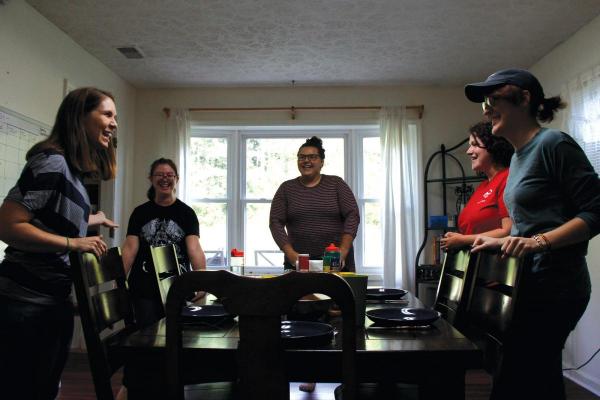
They devoted themselves to the apostles’ teaching and to fellowship, to the breaking of bread and to prayer. Everyone was filled with awe at the many wonders and signs performed by the apostles. All the believers were together and had everything in common. – Acts 2:42-44 (NIV)
Hands clasped to form a chain around the table, attendants hailing from various regions of the country collectively inhale the savory aroma of tomato sauce wafting from the kitchen. A spirit of familiarity imbues the gathering, though these individuals have only recently been introduced. In front of each person is a simple place setting, with plates and glasses representing the blank slate out of which the meal will unfold. Glances and warm smiles are exchanged and, as if choreographed, all eyes close and each head bows. The group prays.
After the prayer, each person lifts their plate and files into the adjacent kitchen, one-by-one so as to not overwhelm the compact space. Spaghetti noodles are scooped onto the plates from a large colander before being covered with a simmering red sauce. All take care to leave space for the salad and bread already placed at the table. There is an air of playfulness and harmony throughout this whole process – lighthearted jokes building to laughter building to words of gratitude and so on. By the time everyone returns to their places around the table, smiling faces reflect warmth and closeness. There are no strangers at this table.
This earned kinship centered around a family-style dinner is not unfamiliar to anyone who has lived as a volunteer in intentional community at Christian Appalachian Project (CAP). This is a typical scene at every CAP volunteer house – four nights a week, every week, to be exact – and is one of the cornerstones of the long-term volunteer experience. Woven within the fibers of this practice of breaking bread together are the three pillars of the Volunteer Program: service, community, and spirituality. The bread broken this particular evening is around the table at the Mount Vernon Volunteer House.
“I like to cook, but it's a little different here,” explains Sarah Harp, a Buffalo, N.Y. native who is halfway through her year of service with the Family Life Child and Family Development Center (CFDC). “At home, it would usually be my mom cooking and me helping her, but I've always liked cooking. My main thing was trying to find new things to make, because whenever I did cook at home it was so infrequent that it didn't matter if I cooked the same thing every time. When I came here I didn't want to cook the same thing too much in a short period of time, so I’ve been trying to find new things to cook.”
At the Mount Vernon House, the four current volunteers have decided to try a new system in which each person has an assigned night of the week to prepare the meal, so planning and coordination is essential.
Harp continues, “We have a limited food stipend per day, per person. We combine these funds for the whole month, for four people. Each week, everyone adds their ingredients to our house shopping list and we make a grocery run. We have to budget and plan our shopping very carefully, and we stick to off-brand products unless there are sales. We buy big jars of peanut butter because in the end it's cheaper than buying little ones every other week or so. My Dad always taught me to look in the left corner of the price tag to find the cost per unit, rather than just considering the larger product price.”
“Because we're on a budget we try to keep the meals simple. Nothing extravagant,” interjects Ohio native Sam Harris, who is also six months into her year of service at Family Life CFDC (and the chef on this night). “We try not to buy something that only one person will use for one meal – we really do have to coordinate what we’re all planning to cook in advance. And we have to be careful to check our pantry closely before we shop and build our meals around what’s already available in the house.”
The tight constraints of a limited budget play a significant role in the types of meals the volunteers tend to prepare. Harris offers some insight into this reality. “We eat a lot of chicken cause it's a more affordable meat. We usually buy a big bag and keep it in the freezer – apart from the occasional pound of ground beef, it’s become the staple protein in our meals. And pasta is very affordable and offers some variety. We always get bananas too, because we know everyone in the house eats them and they’ll never go to waste.”
“We look for items on sale whenever possible and adjust our menu based on that sometimes,” adds Harp.
Serving and living in a region challenged with inordinately high food insecurity rates, a diet determined by thrift is the norm rather than the exception. That volunteers learn to operate and feed one another on this level of economy provides them some additional perspective when interacting with participants struggling with hunger issues. Helena Gallant, from New Britain, Pa., is just beginning her year of service in CAP’s Grateful Bread Food Pantry and she is already discovering these connections.
“The last few days, I’ve just found myself relating to the participants much more. And I grew up on a lot of the foods we eat here in the house and the foods we distribute through the food pantry. I mean, I grew up on things like Hamburger Helper, so it’s not a stretch to share recipe ideas with the people picking up food. It’s a way we can relate to one another on a human level,” describes Gallant.
“I think I’ve learned to appreciate food much more in my time here,” Harp reflects. “I never really thought about food growing up -- my mom just made it. I always came home to dinner on the table. But when we worked with the Summer Feeding Program I realized that there were some kids who were just not getting food when they weren’t being fed by the school and I was stunned. Because as a child, I was always used to dinner just…being there, you know?”
This newfound focus on food – its cost, its preparation, its scarcity, and its value – has a way of connecting volunteers at a deeply human scale with the communities in which they serve. It also tends to build, enhance, and undergird the volunteer community itself. There are few endeavors as intimate, and almost sacred, as breaking bread with one another.
“When we have community dinners,” Harp explains, “or when I have to cook for other people, I try to learn what everyone enjoys so I can factor that in to whatever I plan to make. Like, I know Sam eats a lot of kale and really likes broccoli, so I try to incorporate that in as many ways as possible. It's a combination of bringing what you like into a meal and making sure other people will like it too. So there's thought that goes into it. I remember one dish I kind of wanted to make, but I didn’t think anyone else would really enjoy it, so I didn't make it.”
Maria Hartz, a volunteer from Guilderland, N.Y. who will be serving with short-term volunteer groups, chimes in, “Oh, I'm not good at cooking for just myself. I prefer to cook for other people. I grew up in a very large Italian family, so cooking for one was not something we ever did. To be able to say, ‘Oh, you're cooking for 20? Then invite some more friends’ – that was our mentality. I'm always happy to have more people here. Dinner isn't just dinner – it absolutely is a community. It's time to be with one another and break bread, literally and figuratively, together.”
“As far as preparing food,” Harp explains, “it also gives us the opportunity to help one another. Because Sam was on top of things tonight she didn't need any help, but yesterday, and this is Maria's first week, she offered to help me cook and while I was stirring something she even started cleaning the dishes that I had dirtied up. So, I think it's cool to help each other. You're not in it alone when it's your night to cook.”
Jenny King, CAP Volunteer Life manager and tonight’s dinner guest at the Mount Vernon House, offers some insight. “I'll say for myself, because I do eat with the volunteers a lot and was also a volunteer, it makes you less selfish. In the way that you're eating what someone has prepared for you – and I am very Southern so I would be too polite to not eat something that someone served me – you understand the work that was put into making that meal. And some people just have no experience cooking, so it's a big deal that they found a recipe and cooked it for you. I'm just more appreciative of what goes into a meal.”
Each evening following the meal, after everyone has cleared their plate and assisted with kitchen cleanup, the housemates retreat to their shared living space to engage in a time of devotion with one another. This time is also planned by the person who prepared that night’s food, so there is a thread of continuity from the supper to the spiritual. But this particular evening, the conversation turns toward matters of faith before anyone leaves the table, underscoring the significance of this shared practice of nourishing both the body and the soul.
“This is how I can show love to my housemates – by preparing a meal for them. I’m preparing a devotion for them. It's something very rare and real and physical and it’s a way to say, ‘Yes, I made this meal for you. I love you. Have a great night.’ Just being a servant to one another and expressing that within community is very real,” describes Hartz.
Harp adds, “You can just make dinner or you can make something more than that. You can be lazy about your preparation or you can make something that you're really excited about making for your housemates. But ultimately I think it’s more than the food – it’s the conversation that’s had and connections that are formed around the meal that really give it a spiritual element.”
“And of course, there's prayer. We pray before every meal,” Harp continues. “I feel like that’s an obvious thing, but prayer is a big part of our dinner routine. We do it every time.”
As the dinner comes to its close, King contemplates the significance of this and every volunteer meal. “Something I think about a lot personally is the idea of church. And I think, barring things like sacraments, some of what we do around this table is church. You are praying together. You are breaking bread together. It looks very much like the church of Acts 2, which we'll be reading together tonight in devotion. Just sharing all things in common, serving one another and people in need, sharing all these pieces of one another that create a community. I see Jesus' example reflected when I sit at this table.”








